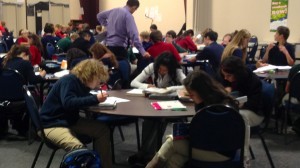Idaho 11th-graders showed some improvement on the Scholastic Aptitude Test in April.
But the state’s average SAT scores still fall well below the college-readiness benchmark established by the College Board, the nonprofit group that administers the exam.
On average, Idaho juniors scored a 1,363 on April 16 — the state’s annual “SAT Day.” That’s a slight increase from 2013, when juniors averaged 1,354 on the college-placement exam.

The scores provide a panoramic snapshot of the state’s graduating class of 2015. All Idaho students must take a college-placement exam in order to graduate high school, and on “SAT Day,” students can take this exam at state expense. Consequently, the vast majority of Idaho juniors take the SAT, and 16,579 Idaho students took the exam on April 16.
Gaining ground, losing ground
Idaho students gained ground on two components of the SAT. Critical reading scores increased from 454 to 464, while math scores improved from 453 to 461. Scores on the writing component of the exam dropped from 447 to 438.
Each component of the SAT is scored on a 200- to 800-point scale, so a perfect score is 2,400. A nine-point increase — the change in the statewide average — translates to an improvement of less than .7 percent.
Still, State Superintendent Tom Luna hailed the progress.
“These results are more evidence that student achievement in Idaho continues to increase and that Idaho’s high school students are moving in the right direction as they prepare to ‘go on’ to postsecondary education.” Luna said in a news release Friday.
The college-ready benchmark
While 2,400 represents a perfect score on the SAT, the magic number may be 1,550.
According to a 2013 College Board report, a 1,550 reflects a college-readiness benchmark. Students who score a 1,550 on the SAT have a 65 percent chance of achieving a first-year college GPA of a B-minus or better. “Studies show that students who meet the SAT College and Career Readiness Benchmark are more likely to enroll in a four-year college, more likely to earn a higher first-year GPA, and more likely to persist beyond the first year of college and complete their degree,” according to the 2013 report.
College readiness, and college success, is a key concern among Idaho education leaders. Idaho’s college attendance rates are historically among the lowest in the nation, and even appear to be dropping slightly.
It is unclear exactly how many Idaho students achieved this 1,550 score in April — not from the 460-page breakdown of SAT scores made available on the State Department of Education’s website.
Spotty success stories
But one fact is clear from the College Board’s detailed breakdown: only a handful of Idaho schools are consistently meeting the benchmark.
Only nine high schools had average SAT scores of 1,550 or higher. That’s less than 5 percent of the 192 high schools listed in the College Board breakdown. (Small schools, with 10 or fewer students taking the SAT, are not incorporated in the report.)
Here’s a list of the nine top-achieving schools, and their average SAT scores:
1. Coeur d’Alene Charter Academy, 1,831.
2. Compass Public Charter, Meridian, 1,663.
3. Renaissance High School, Meridian, 1,626.
4. Victory Charter School, Nampa, 1,588.
5. Xavier Charter School, Twin Falls, 1,566.
6. Idaho Distance Education Academy, based in Post Falls, 1,564.
7. Moscow Senior High School, 1,562.
8. Boise High School, 1,561.
9. Meridian Technical Charter, 1,558.
A few patterns emerge from this short list:
- Seven of the nine high-performing schools are charter schools. Only Boise and Moscow high schools are traditional public high schools.
- Most are small schools — with a small, test-taking sample population. Six of the schools had fewer than 50 test-takers apiece. Taken together, the nine high-performing schools accounted for 940 test-takers, less than 6 percent of the statewide total.
- All of the schools have low student poverty rates, falling well below the statewide rates. In 2013-14, 48.8 percent of students were eligible for free or reduced-priced lunch; Victory had the highest poverty rate of the top-achieving schools, at 35 percent.
